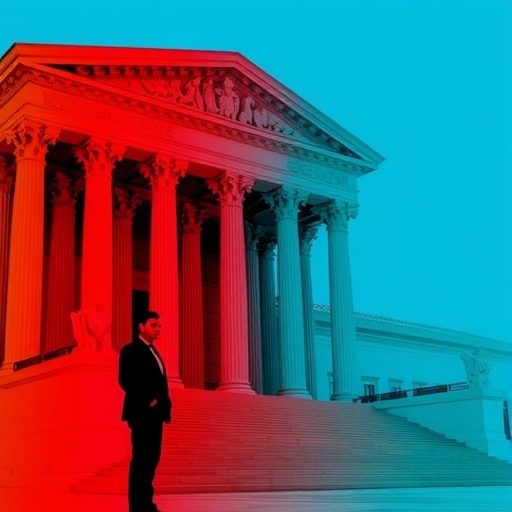Supreme Court Hears Pivotal Arguments in Landmark Voting Rights Act Case, Threatening to Upend Election Laws Nationwide
In a high-stakes showdown that could redefine democracy in America, the U.S. Supreme Court delved into oral arguments on Monday in what legal experts are calling a make-or-break case for the Voting Rights Act. At the center of the fray is Allen v. Milligan, a challenge to Section 2 of the landmark 1965 legislation, where plaintiffs argue that the law’s protections against racial discrimination in voting have been stretched too far, potentially invalidating race-neutral redistricting efforts across the country. With justices firing pointed questions from the bench, the outcome hangs in the balance, poised to ripple through election laws in every state just as the 2024 presidential cycle ramps up.
This isn’t just another courtroom drama; it’s a direct assault on the guardrails established to ensure fair access to the ballot box for minority voters. The case, originating from Alabama’s aggressive redistricting after the 2020 census, spotlights how the Voting Rights Act—once hailed as the crown jewel of civil rights legislation—now faces reinterpretation that could dismantle decades of progress. As crowds gathered outside the marble halls of the Supreme Court, advocates on both sides held their breath, knowing a single ruling could sway congressional maps, voting access, and even the balance of power in Washington.
The arguments unfolded with intensity, lasting over two hours as lawyers for the plaintiffs and defendants clashed over the act’s intent and application. Chief Justice John Roberts set the tone early, probing whether the law’s “totality of circumstances” test unfairly burdens states in drawing district lines. “Is there a point where equity demands we step back?” Roberts asked, highlighting the court’s growing skepticism toward expansive federal oversight in state elections.
Alabama’s Redistricting Battle Ignites National Firestorm
The roots of this Supreme Court case trace back to Alabama’s post-2020 redistricting process, a contentious affair that exposed deep fissures in how states balance population equality with racial equity. After the census revealed shifting demographics, Alabama’s Republican-led legislature crafted seven congressional districts, only one of which was a majority-Black district despite Black voters comprising 27% of the state’s population. Civil rights groups, led by the NAACP Legal Defense Fund, cried foul, filing suit under Section 2 of the Voting Rights Act, which prohibits voting practices that dilute minority voting strength.
A federal trial court in Alabama agreed, finding that the maps likely violated the law by packing Black voters into a single district while spreading them thinly across others, effectively muting their electoral influence. The court ordered a redraw, prompting Alabama’s attorney general to appeal directly to the Supreme Court. This escalation turned a local squabble into a national referendum on the Voting Rights Act’s vitality. “Alabama’s maps aren’t just unfair—they’re a blueprint for suppression,” testified Evan Milligan, the lead plaintiff and a Black voter from Montgomery, during the lower court proceedings. His words echoed the frustration of millions who see the act as their bulwark against Jim Crow-era tactics.
Statistics underscore the stakes: According to the Brennan Center for Justice, states with histories of discriminatory voting laws have seen a 20% drop in minority turnout in recent elections when protections are weakened. In Alabama alone, the disputed maps could have cost Black candidates viable paths to Congress, perpetuating underrepresentation. As the case ascended, it drew amicus briefs from over 60 organizations, including the U.S. Department of Justice, which warned that upholding Alabama’s position would invite a “cascade of challenges” to existing districts nationwide.
But Alabama’s defenders, backed by conservative legal groups like the American Enterprise Institute, framed the challenge as a defense of state sovereignty. They argued that Section 2, as interpreted by lower courts, forces “race-conscious” mapmaking that contravenes the Equal Protection Clause of the 14th Amendment. “We’re not denying rights; we’re preventing reverse discrimination,” asserted Alabama Solicitor General Edmund LaCour during oral arguments, emphasizing that the state’s maps were drawn with surgical precision to achieve one-person, one-vote without racial gerrymandering.
Justices Grill Lawyers on Section 2’s ‘Totality’ Test Limits
Inside the Supreme Court’s ornate chambers, the oral arguments revealed a court deeply divided, with conservative justices pushing back against what they see as judicial overreach in election laws. Justice Clarence Thomas, known for his originalist bent, zeroed in on the Voting Rights Act’s text, questioning whether the “totality of circumstances” standard—borrowed from the 1982 case Thornburg v. Gingles—allows courts to second-guess legitimate state decisions. “Where does it end?” Thomas interjected, his skepticism palpable as he suggested the test has evolved into a tool for endless litigation.
On the liberal side, Justice Sonia Sotomayor mounted a vigorous defense, invoking the brutal history of disenfranchisement that birthed the Voting Rights Act. “This law was passed because states like Alabama couldn’t be trusted,” she remarked sharply, referencing the Selma marches and Bloody Sunday that galvanized Congress in 1965. Sotomayor pressed the state’s lawyer on evidence showing that Black voters in Alabama’s challenged districts faced diluted influence, citing data from the U.S. Census Bureau that Black-preferred candidates won only 14% of elections in those areas from 2012 to 2020.
Justice Brett Kavanaugh, often a swing vote, delved into practical implications, asking how a ruling might affect battleground states like Georgia and Texas, where similar redistricting fights simmer. “If we narrow Section 2, do we open the floodgates to more polarized maps?” he pondered aloud. The exchange highlighted the case’s broader canvas: With the 2022 midterms fresh in memory, where voting rights disputes flipped seats in Congress, the Supreme Court’s decision could recalibrate power dynamics ahead of 2024.
Experts watching the arguments noted a subtle shift. “The conservatives seem poised to rein in the Voting Rights Act, but the oral vibes suggest they’re wary of a full evisceration,” observed election law professor Rick Hasen of UC Irvine in a post-hearing analysis. Hasen’s take aligns with betting odds from legal prediction markets, which give a 65% chance of the court siding with Alabama on at least partial grounds, potentially requiring plaintiffs to prove intentional discrimination rather than just disparate impact.
- Key Moment: When Justice Amy Coney Barrett questioned the feasibility of creating additional majority-minority districts without splintering communities, it underscored the tension between compactness rules and voting protections.
- Counterpoint: Respondents countered with maps proposed by experts, showing how two Black opportunity districts could fit Alabama’s geography without undue racial sorting.
- Broader Data: Nationwide, the Voting Rights Act has blocked over 1,000 discriminatory practices since 1965, per the Department of Justice— a legacy now at risk.
Historical Precedents Shape the High Court’s Deliberations
To grasp the gravity of Allen v. Milligan, one must rewind to the Voting Rights Act’s stormy origins. Enacted amid the Civil Rights Movement, the law targeted Southern states’ insidious barriers like poll taxes and literacy tests, which suppressed Black turnout to abysmal levels—often below 10% in the Jim Crow South. Section 5, the act’s preclearance provision, required federal approval for voting changes in covered jurisdictions, a mechanism gutted by the court’s 2013 Shelby County v. Holder ruling.
That 5-4 decision, penned by Chief Justice Roberts, declared the coverage formula outdated, unleashing a torrent of restrictive laws: strict voter ID requirements in 14 states, polling place closures in minority-heavy areas, and aggressive purges of voter rolls. Post-Shelby, minority turnout dipped by 2-3 percentage points in affected states, according to a 2020 MIT study, fueling calls to bolster Section 2 as the act’s last line of defense.
Yet challengers in the current case draw on Shelby‘s logic, arguing that Section 2 has ballooned into a de facto replacement for preclearance, imposing undue federal control. They point to Brnovich v. Democratic National Committee (2021), where the court limited Section 2 challenges to procedural voting rules, as a harbinger of restraint. In that Arizona case, the 6-3 majority upheld ballot drop-off restrictions, reasoning that not every disparity equates to dilution. “The pendulum is swinging toward deference to states,” noted conservative commentator Ed Whelan of the Ethics and Public Policy Center, who filed a brief supporting Alabama.
Civil rights stalwarts, however, invoke Gingles, the 1986 precedent that established the three-prong test for Section 2 claims: geographic compactness of minority groups, political cohesion, and bloc voting by the majority. Lower courts have applied this rigorously, striking down maps in states like Louisiana and New York. In amicus filings, the Leadership Conference on Civil and Human Rights amassed evidence from 50 years of enforcement, showing the act’s role in electing over 100 minority members to Congress since 1965—a figure that could stagnate without strong protections.
Quotes from historical figures add emotional weight. President Lyndon B. Johnson, signing the act, proclaimed it “the end of an evil system.” Today, echoes of that urgency resound in statements from plaintiffs’ counsel, Deuel Ross, who told the court, “We’re not asking for favors; we’re demanding the promise of the 15th Amendment.”
Election Laws Nationwide Face Uncertain Future
If the Supreme Court rules for Alabama, the fallout could be seismic, upending election laws in at least a dozen states embroiled in redistricting wars. Georgia, for instance, recently redrew maps under Section 2 pressure, creating a second Black-majority district; a narrowed interpretation might reverse that, tilting the state’s 14 electoral votes toward Republicans. Similarly, in Florida and Ohio, ongoing lawsuits hinge on the “totality” test, with potential to redraw lines that favored GOP gains in 2022.
Statistics paint a dire picture: The Princeton Gerrymandering Project estimates that weakened Voting Rights Act enforcement could entrench partisan bias, reducing competitive districts by 15% and amplifying gerrymandering’s effects. Voter suppression tactics, from felony disenfranchisement affecting 5.2 million Americans (per the Sentencing Project) to absentee ballot restrictions, would face fewer checks. “This case isn’t abstract—it’s about whose voices count in our democracy,” warned Stacey Abrams, founder of Fair Fight Action, in a statement post-arguments.
Conversely, a victory for the plaintiffs would reinforce Section 2’s teeth, encouraging challenges in underlitigated states like Mississippi and South Carolina. It could spur Congress to revive preclearance via the John Lewis Voting Rights Advancement Act, stalled since 2021. Legal scholars predict a 9-0 affirmation of the law’s core but splits on remedies, with moderates like Kavanaugh possibly crafting a middle path.
Looking ahead, the court is expected to issue its opinion by late June 2024, just as states finalize primary maps. Election officials are already bracing: The National Conference of State Legislatures reports a 30% uptick in Voting Rights Act litigation since Shelby, and this ruling could either quell or ignite that trend. As America hurtles toward another divisive election, the justices’ words today may echo in ballot boxes tomorrow, determining not just who votes, but who wins.
In the words of Justice Elena Kagan during arguments, “The right to vote is preservative of all rights.” With so much at stake, the nation watches, hoping the court upholds that foundational truth.









